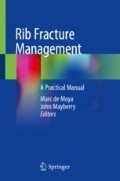Abstract
The goal of this algorithm is to recognize patients who are high risk for respiratory compromise and guide analgesia, pulmonary support, and clinical monitoring. Implementation of a structured rib fracture management algorithm has been shown to decrease ICU and hospital lengths of stay, pneumonia, and mortality.
Access this chapter
Tax calculation will be finalised at checkout
Purchases are for personal use only
References
Todd SR, McNally MM, Holcomb JB, Kozar RA, Kao LS, Gonzalez EA, Cocanour CS, Vercruysse GA, Lygas MH, Brasseaux BK, et al. A multidisciplinary clinical pathway decreases rib fracture-associated infectious morbidity and mortality in high-risk trauma patients. Am J Surg. 2006;192:806–11.
Holcomb JB, Moore FA, et al. Morbidity from Rib Fractures Increases After Age 45. JACS. 2003 Oct;196(4):549–55.
Dehghan N, de Mestral C, McKee MD, Schemitsch EH, Nathens A. Flail chest injuries: a review of outcomes and treatment practices from the National Trauma Data Bank. J Trauma Acute Care Surg. 2014;76:462–8.
Hamrick MC, Duhn RD, Ochsner MG. Critical evaluation of pulmonary contusion in the early post-traumatic period: risk of assisted ventilation. Am Surg. 2009;75:1054–8.
Witt C, Bulger E. Comprehensive approach to the management of the patient with multiple rib fractures: A review and introduction of a bundled rib fracture management protocol. Trauma Surgery Acute Care Open. 2017;2:e00064.
Bulger EM, Arneson MA, Mock CN, Jurkovich GJ. Rib fractures in the elderly. J Trauma. 2000;48:1040–6. discussion 1046–7
Stawicki SP, Grossman MD, Hoey BA, Miller DL, Reed JF III. Rib fractures in the elderly: a marker of injury severity. J Am Geriatr Soc. 2004;52:805–8.
Rockwood K, et al. A global clinical measure of fitness and frailty in elderly people. CMAJ. 2005 Aug 30;173(5):489–95.
Brasel K, Moore E, Biffl W, et al. Western Trauma Association Critical Decisions in Trauma: Management of Rib Fractures. J Trauma Acute Care Surgery. 2016;82(1):200.
Battle CE, Hutchings H, Evans PA. Risk factors that predict mortality in patients with blunt chest wall trauma: a systematic review and meta-analysis. Injury. 2012;43:8–17.
Galvagno SM Jr, Smith CE, Varon AJ, Hasenboehler EA, Sultan S, Shaefer G, To KB, Fox A, Alley DE, Ditillo M, et al. Pain management for blunt thoracic trauma: a joint practice management guideline from the Eastern Association for the Surgery of Trauma and Trauma Anesthesiology Society. J Trauma Acute Care Surg. 2016;81:936–51.
Rafiq S, Steinbruchel DA, Wanscher MJ, Andersen LW, Navne A, Lilleoer NB, Olsen PS. Multimodal analgesia versus traditional opiate based analgesia after cardiac surgery, a randomized controlled trial. J Cardiothorac Surg. 2014;9:52.
Bayouth L, Safcsak K, Cheatham ML, Smith CP, Birrer KL, Promes JT. Early intravenous ibuprofen decreases narcotic requirement and length of stay after traumatic rib fracture. Am Surg. 2013;79:1207–12.
Yang Y, Young JB, Schermer CR, Utter GH. Use of ketorolac is associated with decreased pneumonia following rib fractures. Am J Surg. 2014;207:566–72.
Bulger EM, Edwards T, Klotz P, Jurkovich GJ. Epidural analgesia improves outcome after multiple rib fractures. Surgery. 2004;136:426–30.
Mohta M, Verma P, Saxena AK, Sethi AK, Tyagi A, Girotra G. Prospective, randomized comparison of continuous thoracic epidural and thoracic paravertebral infusion in patients with unilateral multiple fractured ribs—a pilot study. J Trauma. 2009;66:1096–101.
Author information
Authors and Affiliations
Corresponding author
Editor information
Editors and Affiliations
Rights and permissions
Copyright information
© 2018 Springer International Publishing AG, part of Springer Nature
About this chapter
Cite this chapter
Biffl, W., Zhao, F. (2018). Rib Fracture Management Algorithm for the Traumatically Injured, Non-intubated Patient. In: de Moya, M., Mayberry, J. (eds) Rib Fracture Management . Springer, Cham. https://doi.org/10.1007/978-3-319-91644-6_10
Download citation
DOI: https://doi.org/10.1007/978-3-319-91644-6_10
Published:
Publisher Name: Springer, Cham
Print ISBN: 978-3-319-91643-9
Online ISBN: 978-3-319-91644-6
eBook Packages: MedicineMedicine (R0)

